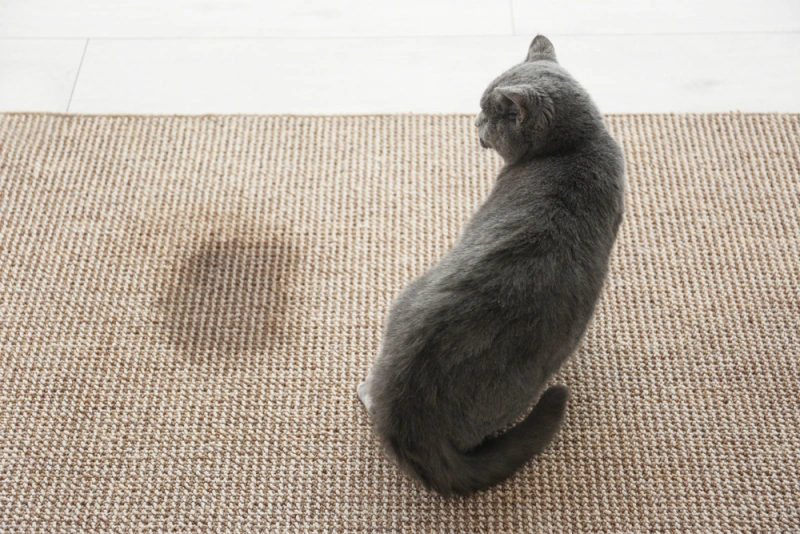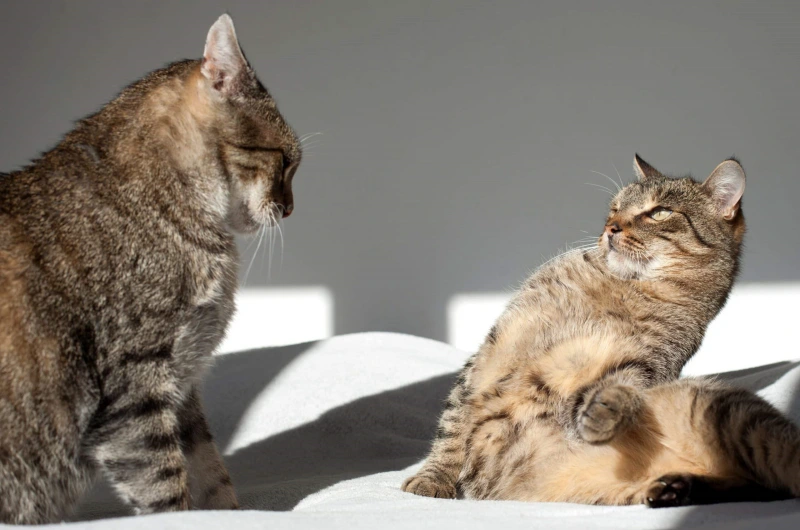Are you struggling with a cat that keeps peeing outside the litter box? This can be a frustrating problem for any cat owner. Many factors contribute to this behavior, including stress, litter preferences, and even the location of the litter box itself. Understanding these issues is crucial to finding a solution. In this article, we’ll share practical tips on how to stop cat from peeing outside litter box. Ready to restore peace in your home? Let’s get started!
Why Is My Cat Peeing Outside The Litter Box?

Here are the reasons cats pee outside litter box in the following, and let’s see what causes a cat to pee outside the litter box.
Medical Reasons
Urinary Tract Infection: Urinary tract infections (UTIs) are common in cats and can lead to significant discomfort. If your cat is straining to urinate, crying out, or making frequent trips to the litter box, a UTI may be the culprit. The irritation causes urgency, making your cat look for relief elsewhere.
Bladder Stones: Bladder stones can form in your cat’s urinary tract, causing pain and potential blockages. When these stones obstruct urine flow, your cat may feel the need to eliminate outside the litter box. You might notice your cat trying to go frequently, but with little success. This condition can be serious, so it’s crucial to seek veterinary help immediately.
Idiopathic Cystitis: Idiopathic cystitis is a frustrating condition because it involves inflammation of the bladder with no clear cause. It often relates to stress, and cats may react by avoiding the litter box. Signs include frequent attempts to urinate and sometimes blood in the urine. Managing your cat’s environment can help reduce stress.
Metabolic Disease: Metabolic diseases like kidney disease or diabetes can significantly impact your cat’s urination habits. These conditions often lead to increased thirst and frequent urination, causing accidents outside the litter box.
Systemic Disease: Systemic diseases, such as degenerative joint disease, can affect your cat’s ability to use the litter box. Pain or difficulty moving may prevent them from getting to the box in time. If your cat is older or showing signs of discomfort, it’s important to assess their mobility.
Hyperthyroidism: Hyperthyroidism is a common condition in older cats that can increase their urination frequency and urgency. If your cat seems restless or is drinking and urinating more than usual, this could be the reason. Besides litter box issues, other signs include weight loss and increased appetite.
Environmental Reasons
Multiple Pets in the Home: When you have multiple pets, your cat might feel overwhelmed. Competition for attention or resources can create tension. If your cat feels threatened by other animals, they may choose to pee outside the litter box as a way to mark their territory or to avoid conflict.
Litter Box Preferences: Cats can be picky about their litter boxes. They might not like the type of litter you use or the box’s design. Some prefer covered boxes, while others like open ones. If your cat is avoiding the box, try different litter types or styles. Finding the right combination can make a huge difference in their willingness to use it.
Dirty Litter Box: A dirty litter box is one of the main reasons cats refuse to use it. Cats are clean animals, and if the box smells or has clumps, they might seek alternative spots. Regular maintenance is key.
Litter Box Location:The location of the litter box can also impact its use. If it’s too close to loud noises or high-traffic areas, your cat may feel uncomfortable. They prefer a quiet, safe spot where they can do their business in peace.
Cat Behavior Problems Peeing Outside Litter Box
If your cat is consistently urinating outside the litter box, it’s important to address the underlying issue to prevent further problems.
Common Causes and Solutions:
- Litter Box Issues:
- Size: Ensure the litter box is large enough for your cat to comfortably stretch and turn around.
- Location: Place the box in a quiet, private area away from food and water sources.
- Cleanliness: Clean the box daily and scoop out solid waste regularly.
- Litter Type: Experiment with different litter types to find one your cat prefers.
- Medical Problems:
- Urinary Tract Infections (UTIs): Consult a veterinarian for diagnosis and treatment.
- Kidney Disease: Regular check-ups can help detect and manage this condition.
- Diabetes: Monitor your cat’s blood sugar levels and follow your vet’s advice.
- Stress and Anxiety:
- Identify stressors: Look for changes in the environment, new pets, or loud noises that might be causing stress.
- Create a calming environment: Provide hiding places, scratching posts, and toys to reduce anxiety.
- Consult a veterinarian: They can recommend calming aids or behavior modification techniques.
- Territorial Marking:
- Neutering or spaying: This can help reduce territorial behavior.
- Provide additional litter boxes: This can help prevent marking behavior.
Additional Tips:
- Positive Reinforcement: Reward your cat with treats or praise when they use the litter box.
- Temporary Confinement: If the problem persists, temporarily confine your cat to a small area with the litter box.
- Professional Help: Consult a veterinarian or feline behaviorist for personalized advice.
Remember: It’s essential to approach this issue with patience and understanding. By addressing the root cause and providing a supportive environment, you can help your cat return to using the litter box as intended.
11 Tips for How To Stop Cat From Peeing Outside Litter Box

Here are some tips about how to prevent cats from peeing outside the litter box
1. Aversion Therapy
If your cat is peeing in specific areas, consider aversion therapy. Use safe deterrents like double-sided tape or aluminum foil in those spots. Cats dislike the texture and will avoid it. This simple trick helps redirect your cat’s behavior back to the litter box, encouraging them to use the proper place instead of your carpet or furniture.
2. Try Odor-Neutralizing Products
After cleaning up cat messes, use odor-neutralizing products designed for pet urine. Regular cleaners may not eliminate the smell completely, but these specialized products break down the enzymes in cat urine. By removing lingering odors, you discourage your cat from returning to the same spot, promoting better litter box habits.
3. Keep Your Kitty Out of Your Plants

Cats often see houseplants as a potential bathroom. To deter this behavior, keep your plants out of reach or use deterrents like citrus peels or commercial sprays that cats dislike. By creating a cat-friendly environment, you can redirect their instincts and keep your plants safe from unwanted attention.
4. Attraction Therapy
Make the litter box more inviting with attraction therapy. Place treats or a sprinkle of catnip near the box to encourage your cat to use it. This positive reinforcement helps them associate the litter box with good experiences. Rewarding your cat with praise when they use the box reinforces this behavior and can make a significant difference.
5. Buy A New Litter Box
If your cat continues to avoid the litter box, consider buying a new one. Cats can be picky about their boxes, so trying different styles, like covered or extra-large boxes, may help. A new, clean box can be more appealing and might encourage your cat to use it consistently, solving your litter box dilemma.
6. One Box Per Cat (Plus One)
For households with multiple cats, the rule of thumb is to have one litter box per cat, plus one extra. This ensures that each cat has access without feeling competition. By reducing territorial disputes and providing enough resources, you can lower stress levels and encourage better litter box usage among your furry friends.
7. Clean Litter Box Often

Cats are naturally clean animals, so maintaining a tidy litter box is essential. Scoop the litter daily and change it completely at least once a week. A clean box encourages your cat to use it instead of seeking alternatives. Regular maintenance not only keeps the box inviting but also shows your cat that it’s a safe and comfortable place to go.
8. Choose Unscented Clumping Litter
Many cats dislike strong scents in litter. Opting for unscented clumping litter is often a better choice, as it controls odors without overwhelming your cat’s sensitive nose. Trying different brands can help you discover the perfect litter that your cat enjoys, making them more likely to use the box consistently.
9. Suitable Litter Box Placement
The location of the litter box plays a crucial role in its usage. Place it in a quiet, low-traffic area where your cat feels safe. Avoid putting it near food and water bowls, as cats prefer their bathroom space to be separate. A comfortable, private spot encourages your cat to use the litter box regularly.
10. Consult Your Veterinarian
If your cat continues to pee outside the litter box, it’s time to consult your veterinarian. There may be underlying health issues, like urinary tract infections or other medical conditions, that need attention. Getting a professional opinion can help identify and address any health problems that could be contributing to the behavior.
11. Reduce Conflict Between Your Cats

In multi-cat households, conflicts can lead to stress and inappropriate elimination. To minimize tension, provide separate resources for each cat, including food, water, and litter boxes. By ensuring that each cat has its own space and resources, you can help reduce stress levels and promote healthier litter box habits.
Why Do Cats Poop Outside Their Litter Box

There are several reasons why a cat might poop outside their litter box:
Litter Box Issues:
- Litter Box Size: The box might be too small.
- Litter Type: The litter might be unpleasant or irritating to the cat.
- Box Location: The box might be in a noisy or high-traffic area.
- Box Cleanliness: A dirty litter box can be off-putting to a cat.
Medical Issues:
- Constipation: Difficulty passing stools can lead to accidents.
- Diarrhea: Loose stools can make it difficult to control bowel movements.
- Painful Conditions: Arthritis or other painful conditions can make it difficult to get in and out of the litter box.
Behavioral Issues:
- Stress or Anxiety: Changes in the environment, new pets, or other stressors can cause behavioral changes.
- Territorial Marking: Unneutered or unspayed cats might mark their territory with feces.
If your cat is consistently pooping outside the litter box, it’s important to consult with a veterinarian to rule out any medical issues. Once medical problems are addressed, you can focus on behavioral or environmental factors.
Here are some tips to encourage your cat to use the litter box:
- Clean the litter box regularly.
- Experiment with different litter types.
- Ensure the litter box is in a quiet, private location.
- Provide additional litter boxes.
- Consider a calming pheromone diffuser.
- If necessary, consult with a feline behaviorist.
By addressing the underlying cause, you can help your cat return to using the litter box as intended.
How to Encourage Cat to Pee in Litter Box
Here are some tips to help your cat return to using the litter box:
Litter Box Maintenance:
- Cleanliness: Clean the litter box daily, and scoop out solid waste regularly.
- Litter Type: Experiment with different litter types. Some cats prefer clay litter, while others prefer silica gel or recycled paper.
- Box Size: Ensure the litter box is large enough for your cat to comfortably move around in.
- Box Location: Place the litter box in a quiet, private area away from food and water sources.
Medical Check-up:
- Rule out medical issues: If your cat has recently started urinating outside the litter box, it’s a good idea to consult with a veterinarian to rule out any underlying medical conditions.
Behavioral Strategies:
- Positive Reinforcement: Reward your cat with treats or praise when they use the litter box.
- Reduce Stress: Identify and address any potential stressors in your cat’s environment.
- Provide Additional Litter Boxes: If you have multiple cats or your cat is particularly anxious, consider adding more litter boxes.
- Cover the Litter Box: Some cats prefer privacy when using the litter box. Covering the box can help create a more secluded environment.
Temporary Solutions:
- Confinement: If your cat is persistently urinating outside the litter box, you may need to temporarily confine them to a small area with the litter box. This can help them relearn the proper elimination behavior.
- Cleaning Affected Areas: Thoroughly clean any areas where your cat has urinated outside the litter box. Use a cleaner specifically designed for pet urine to remove the odor and discourage future accidents.
Remember, patience is key. It may take some time for your cat to adjust to using the litter box again. By following these tips and working closely with your veterinarian, you can help your cat return to normal elimination habits.
Conclusion
Finding a solution to your cat’s litter box issues can feel overwhelming, but it’s entirely possible! By understanding the reasons behind their behavior and applying the tips we discussed, you can create a welcoming space that encourages your kitty to use their litter box. Remember to keep it clean, provide the right litter, and ensure your cat feels safe.
For the best results, explore our top-quality cat litter options. With the right products and knowledge on how to stop cat from peeing outside litter box, you’ll help restore peace in your home. Check out our cat litter today!
FAQ
How to get cat to pee in litter box?
To encourage your cat to use the litter box, ensure it’s clean and placed in a quiet, safe location. Use unscented clumping litter that your cat prefers, and try adding a few treats or catnip near the box to attract them.
How to encourage cat to pee in litter box?
Create a positive environment by regularly cleaning the litter box and ensuring it’s easily accessible. Consider using multiple boxes if you have several cats. Positive reinforcement, like treats or praise, when your cat uses the box can also help.
How does cat pee get under the litter box?
Cat pee can seep under the litter box due to litter being kicked around or when the box isn’t cleaned regularly. If the box is too small or the litter is too shallow, it may not contain all the urine. A larger box and deeper litter can help prevent this issue.
How to clean cat pee from litter box?
To clean cat pee from the litter box, first, remove all litter and rinse the box with warm water. Use a mild detergent or a pet-safe cleaner to scrub the inside. Rinse thoroughly, dry the box, and refill it with fresh litter.
How to correct cat peeing outside litter box?
Identify the cause of the behavior, such as stress, dirty litter, or health issues. Address any environmental factors, ensure the litter box is clean and accessible, and consult your veterinarian if the problem persists to rule out medical conditions.









